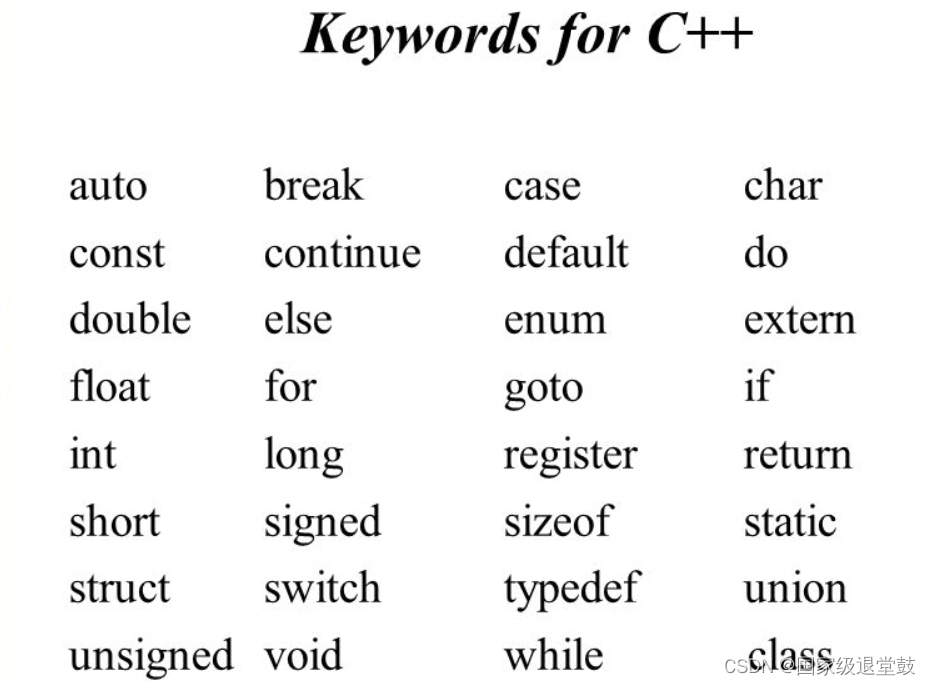C++入门编程一(基本框架代码、宏定义、标识符、数据类型)
基于b站黑马c++视频做的笔记,仅供参考和复习!!!
一、基本框架代码解释
#include <iostream>
using namespace std;
int main()
{
cout << "hello world1" << endl;
system("pause");
return 0;
}
#include <iostream>
编译器:Visual Studio 2022
编译预处理:#include 包含头文件命令,用于引用后面的<>中iostream文件中的代码。
编译之前就会被替换成 iostream文件文件的内容
iostream 意为输入输出流(i-o-stream) 包含如cout、endl等内置类的对象
使用尖括号< >,编译器会到系统路径下查找头文件
使用双引号" “,优先当前源文件所在的工作目录中进行查找,再到默认头文件系统路径下查找
补:#include <stdio.h>,其中stdio 就是指 “standard input & output”(标准输入输出)
using namespace std;
using namespace 为关键字 , std是C++标准库所在空间的名称
using是一个编译指令,该指令使指定的命名空间中的名称std对该指令后面的程序可用
namespace 命名空间,本质上定义一个范围,指标识符的各种可见范围。C++标准程序库中的所有标识符都被定义于一个名为std的namespace的空间中,它可作为附加信息来区分不同库中相同名称的函数、类、变量等
cout << "hello world1" << endl;
cout来源于iostream源文件,是一个对象,作用是把通过<<把输入的消息显示在屏幕上
<<作用就是把右边的信息以流的方式插入左边的cout中,<<被重载成了插入运算符
endl表示换行符,它用来向缓冲区插入换行符号并刷新
system("pause");
system(“pause”) 程序暂停 按任意键继续,若没有,程序在运行完后就会马上消失
system()函数调用(DOS)系统命令。 pause ,即DOS命令集合中的暂停命令
return 0;
return 定义返回值, return 0可以终止main() 函数,并返回值 0
return 0 代表程序正常退出,return 1代表程序异常退出
main函数比较特殊,不用写return 0程序也能正常运行
多行注释
(1)Ctrl+Shift+/
(2)依次按下Ctrl+K+C,即可实现多行注释;取消注释Ctrl+K+U
缩进
Tab向前缩进,Shift+Tab向后缩进
自动排版
依次按下Ctrl+K+F可快速将写的代码排版
宏定义
//#define 宏名 替换文本
#define Day 7
“#”表示这是一条预处理命令。凡是以“#”开头的均为预处理命令。“define”为宏定义命令。“Day”为所定义的宏名。“替换文本”可以是常数、表达式、格式串等。
在预处理工作过程中,代码中所有出现的“宏名”,都会被“替换文本”替换。这个替换的过程被称为**“宏代换”或“宏展开”**。
关键字
关键字:具有特殊意义的预定义保留标识符。 它们不能用作程序中的标识符。

//错误,第二个是关键字,不可以作为变量的名称
int int = 10;
标识符命名规则
标识符不可以是关键字,标识符是由字母、数字、下划线构成。
标识符第一个字符只能是字母或者下划线,标识符是区分大小写的。
标识符
//1、短整型 (-32768 ~ 32767) 2字节
short num1 = 10;
//2、整型 4字节 64位和32位 而在16位系统占2个字节
int num2 = 10;
//3、长整型 4字节
long num3 = 10;
//4、长长整型 8字节
long long num4 = 10;
//补充 无符号短整型 (0~65535) 2字节
unsigned short num5 = 10;
sizeof()关键字
可以用sizeof求出数据类型占用的内存大小
语法:sizeof(数据类型 / 变量名)
short num1 = 10;
cout << "short占用内存空间为:" << sizeof(short) << endl;
int num2 = 10;
cout << "short占用内存空间为:" << sizeof(num2) << endl;
实型(浮点型)
C++中cout默认输出六位有效数字
float f1 = 3.1415926f;
cout << "f1 = " << f1 << endl;
double f2 = 3.1415926;
cout << "f2 = " << f2 << endl;
//统计内存空间
cout << sizeof(double) << endl; //8子节
cout << sizeof(float) << endl; //4字节
//科学计数法
float f3 = 4e2; //4* 10^2
cout << "f3 = " << f3 << endl;
float f4 = 4e-2; //4*0.1^2
cout << "f4 = " << f4 << endl;

字符型
创建字符型变量用单引号且里面只有一个字符
char ch = 'a';
cout << ch << endl;
cout << sizeof(ch) << endl;
// 字符型变量对应ASCII编码
// a-97 A-65
cout << (int)ch << endl; //输出97
转义字符
1、换行符 \n 2、反斜杠\ 3、水平制表符 \t
cout << "hello world\n" ;
cout << "\\\n";
cout << "\\" << endl;
cout << "aaa\thelloworld" << endl; //\t宽度为8
cout << "aaaaa\thelloworld" << endl;//作用可以整齐的输出数据
cout << "aaaa\thelloworld" << endl;

字符串类型
//1. C风格字符串
char str[] = "hello world";
cout << str << endl;
//2. C++风格字符串
string str2 = "hello world";
cout << str2 << endl;
布尔类型
布尔数据类型代表真或假的值,bool类型只有两个值
- true — 真(本质是1)
- false — 假(本质是0)
bool flag = true; //true代表真
cout << flag << endl; //输出1
flag = false; //假
cout << flag << endl; //输出0
cout << sizeof(bool) << endl; //1个字节
数据的输入
//1、整型
int a = 0;
cout << "请给a赋值" << endl;
cin >> a;
cout << "a = " << a << endl;
//2、字串型
string str = "hello";
cout << "请给str赋值" << endl;
cin >> str;
cout << "赋值为:" << str << endl;

注:以上基于黑马程序员C++课程的自用笔记,谢谢!
本文来自互联网用户投稿,该文观点仅代表作者本人,不代表本站立场。本站仅提供信息存储空间服务,不拥有所有权,不承担相关法律责任。 如若内容造成侵权/违法违规/事实不符,请联系我的编程经验分享网邮箱:chenni525@qq.com进行投诉反馈,一经查实,立即删除!
- Python教程
- 深入理解 MySQL 中的 HAVING 关键字和聚合函数
- Qt之QChar编码(1)
- MyBatis入门基础篇
- 用Python脚本实现FFmpeg批量转换
- [Java][IOStream][BuffedReader]的readLine/writeLine方法-游戏储存信息必备
- 网络安全好就业吗?那是当然
- 在Fiber中处理请求和响应
- SCTP, TCP, UDP, IP, ICMP都在哪一层?(TCP/IP网络通信协议学习)
- 基于Ray和vLLM构建70B+模型的开源RLHF全量训练框架
- 7款创意性前端源码特效资源分享(附在线预览效果)
- 中文医疗大模型的近况
- 百度CTO王海峰:文心一言用户规模破1亿
- Kylin的工作原理
- flutter给组件设置背景图的操作